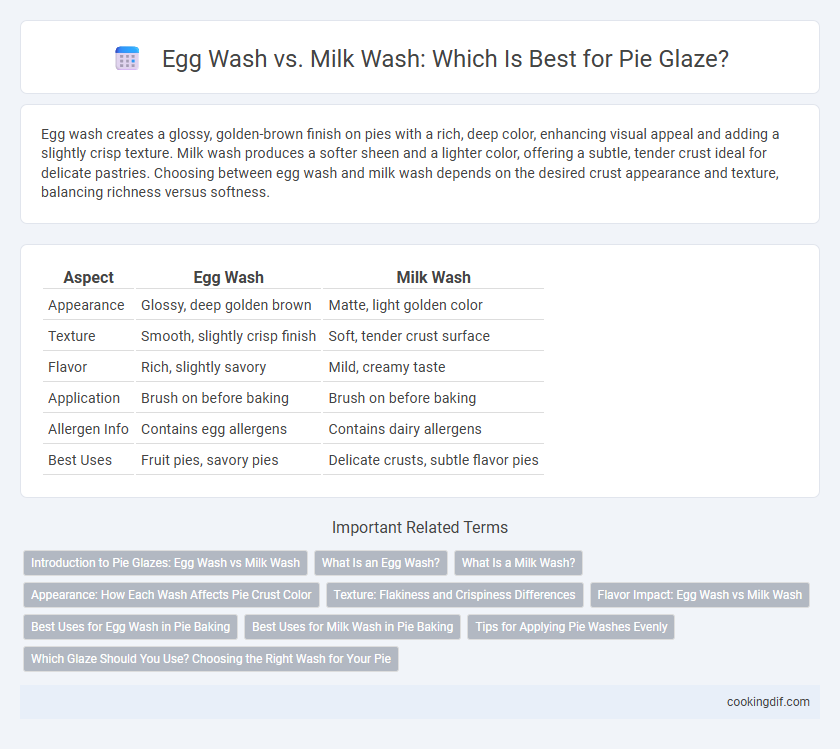Egg wash creates a glossy, golden-brown finish on pies with a rich, deep color, enhancing visual appeal and adding a slightly crisp texture. Milk wash produces a softer sheen and a lighter color, offering a subtle, tender crust ideal for delicate pastries. Choosing between egg wash and milk wash depends on the desired crust appearance and texture, balancing richness versus softness.
Table of Comparison
| Aspect | Egg Wash | Milk Wash |
|---|---|---|
| Appearance | Glossy, deep golden brown | Matte, light golden color |
| Texture | Smooth, slightly crisp finish | Soft, tender crust surface |
| Flavor | Rich, slightly savory | Mild, creamy taste |
| Application | Brush on before baking | Brush on before baking |
| Allergen Info | Contains egg allergens | Contains dairy allergens |
| Best Uses | Fruit pies, savory pies | Delicate crusts, subtle flavor pies |
Introduction to Pie Glazes: Egg Wash vs Milk Wash
Pie glazes enhance crust color and texture, with egg wash providing a rich, glossy finish due to the proteins and fats in yolks, making it ideal for golden-brown appeal. Milk wash offers a subtler sheen and softer crust, as lactose promotes gentle browning without the intense gloss of egg. Selecting between egg wash and milk wash depends on desired visual effect and crust crispness, influencing the overall pie presentation.
What Is an Egg Wash?
An egg wash is a mixture of beaten eggs, sometimes combined with water or milk, applied to pie crusts before baking to create a glossy, golden finish. It enhances the pie's appearance by promoting even browning and adding a slight sheen to the crust. Egg wash differs from milk wash by providing a richer color and a more durable glaze due to the protein content in eggs.
What Is a Milk Wash?
A milk wash is a simple mixture of milk applied to pie crusts before baking to achieve a soft, golden-brown finish that enhances the pie's appearance. Unlike egg wash, which creates a glossy and more pronounced shine, milk wash contributes a subtle sheen and promotes gentle browning without altering the crust's texture significantly. This technique is ideal for delicate pies where a natural, understated glaze is preferred.
Appearance: How Each Wash Affects Pie Crust Color
Egg wash creates a rich, golden-brown pie crust with a glossy finish, enhancing the pie's visual appeal through proteins that caramelize during baking. Milk wash yields a softer, matte crust color, contributing to a subtler sheen and lighter browning due to its natural sugars and fat content. Bakers often choose egg wash for vibrant, shiny pies, while milk wash suits pies needing a gentle, even crust tone.
Texture: Flakiness and Crispiness Differences
Egg wash creates a glossy, golden-brown finish that enhances pie crust flakiness by promoting more even browning and a slightly crisp texture. Milk wash results in a softer, matte glaze that contributes to a tender crust with less crispiness and a more delicate texture. Choosing between egg wash and milk wash significantly impacts the pie's outer texture, with egg wash favoring flakiness and crispiness, while milk wash emphasizes softness.
Flavor Impact: Egg Wash vs Milk Wash
Egg wash imparts a rich, savory flavor and a deep golden color that enhances the pie's crust, creating a luscious, slightly crispy texture. Milk wash offers a subtle sweetness with a softer, less intense glaze, resulting in a tender crust and a delicate shine. Choosing egg wash elevates flavor complexity, while milk wash preserves natural dough taste with a gentle gloss.
Best Uses for Egg Wash in Pie Baking
Egg wash, made from beaten eggs often mixed with water or milk, provides a rich, glossy finish ideal for savory pies and crusts that require a golden-brown appearance and a slightly crisp texture. Its protein content helps create a strong, shiny glaze that enhances the visual appeal of fruit pies, meat pies, and puff pastry-based crusts. Best uses for egg wash include sealing pie edges to prevent filling leakage and achieving a vibrant surface that withstands high oven temperatures without burning.
Best Uses for Milk Wash in Pie Baking
Milk wash creates a tender, golden-brown crust on pies by adding moisture and subtle sweetness, ideal for fruit pies like apple or cherry. It enhances the pie's appearance with a soft sheen without overpowering delicate fillings or crust flavors. Using milk wash is best when aiming for a gentle glaze that complements flaky crusts while preventing excessive browning or crispiness.
Tips for Applying Pie Washes Evenly
Use a pastry brush with soft, natural bristles to apply egg wash or milk wash evenly over your pie crust, ensuring smooth and consistent coverage without pooling. Apply the wash in thin layers, brushing gently in one direction to avoid disturbing the dough and achieve a uniform golden glaze. Chilling the pie before washing helps the glaze adhere better, resulting in an evenly browned and glossy finish.
Which Glaze Should You Use? Choosing the Right Wash for Your Pie
Egg wash creates a rich, glossy finish with a deep golden color, perfect for traditional fruit pies and savory tarts, while milk wash offers a softer, matte sheen that enhances buttery crusts without overpowering delicate flavors. Opt for egg wash when you want a dramatic shine and a slightly crispier texture, especially on pies with intricate designs or lattice tops. Choose milk wash to achieve a subtle, tender crust ideal for cream pies or when a less bold glaze is desired.
Egg Wash vs Milk Wash for pie glaze Infographic

 cookingdif.com
cookingdif.com